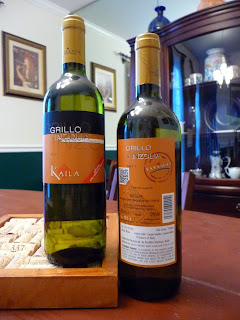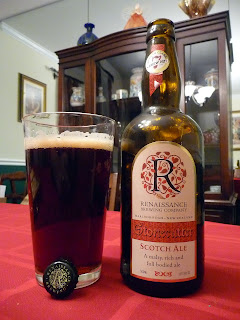Recently, Clare and I had the challenge to pair wines with a four course dinner. We have previously undertaken such challenges, pairing wine with dinners that featured
Spanish cuisine and
Mexican cuisine. This dinner did not focus upon a particular country's cuisine; instead, it focused upon a particular season. This was an Autumnal dinner. Each course featured ingredients typically associated with the fall season, like cranberries, butternut squash, and pumpkin. While the menu sounded delicious, the ingredients presented quite the challenge when it came to the wine pairing.
Not only did I accept the challenge, but I also upped the ante. Rather than going with safe bets (like Prosecco, Pinot Noir, Chardonnay or Port), I decided that I would look for possible pairings from some less well known wines. This process began by finding what were the common pairings. I then consulted Joshua Wesson's
Wine & Food to find some other varietals that fall within the style of wine. I also consulted
The Flavor Bible, looking for the flavors that best matched the ingredients in each dish. I then cross referenced those flavors with wine reviews to find a wine that would match each course. Unlike the prior wine pairings, this one involved a lot of gut checking and risk taking.
Deinhard Lila Riesling Sekt Trocken
Paired with Toasted Hazelnut Salad with Dried Cranberries and Hazelnut Vinaigrette
The first course was a Toasted Hazelnut Salad with Dried Cranberries and Hazelnut Vinaigrette. Obviously, the two principal ingredients to focus upon for purposes of wine pairing are the dried cranberries and hazelnuts. These ingredients paired well with any wine that has aromas or flavors of apples, apricots, hazelnuts, lemons, oranges and/or pears.
The conventional pairings for this dish focused upon a Riesling or a sparkling wine, such as Champagne or Prosecco. I went with a Riesling ... but not just not any ordinary Riesling. Instead, I chose the Deinhard Lula Riesling Sekt Trocken. A Sekt is a sparkling wine produced in Germany and Austria. Many winemakers use the
Method Champenoise to make Sekt, while others use the
Method Charmat. The principal difference between the two methods is that the
Method Champenoise requires the secondary fermentation to take place in the bottles while the
Method Charmat provides for that fermentation to take place in stainless steel tanks. (The
Method Charmat is most commonly used to make Prosecco.)
The Deinhard Lila -- which comes from Mosel, Germany -- is produced with Riesling grapes using the
Method Charmat. The winemakers describe the resulting wine as having a pale yellow color with green inflections. They also describe the Lila as having an aroma of peaches and apricots, with a light lilac presence. Those elements -- peaches and apricots -- are two ingredients that can be matched to both dried cranberries and hazelnuts. The effervescence of the wine should also work well with the hazelnut vinaigrette, helping to bring some lightness to the salad.
Cave de Tain Marsanne (2011)
Paired with Butternut Squash Soup
The next course was a traditional butternut squash soup. The principal ingredients in this dish are the butternut squash (obviously), as well as the carrots and Granny Smith apple. These were the ingredients that I primarily focused upon when researching a wine pairing. I also had to keep in mind that this dish also included garlic, carrots, thyme, and caraway seeds.
The traditional pairing for a butternut squash soup may be a Viognier or Gewurztraminer wine. According to Joshua Wesson, these types of wines tend to be soft wines (dry or off-dry with a low alcohol content and from a recent vintage), and the Viognier could be a rich white, which could be a smoother, more complex wine. The idea of a smooth wine intrigued me with this soup, because I think that the smoothness of the wine could highlight the fundamental character of a butternut squash soup, without going overboard when it comes to the texture.
With this in mind, my challenge forced me to look for another varietal or style of wine that could accomplish the same objective. One type of rich wine wines discussed by Wesson in his book are Marsanne. This is a white varietal found mostly in the Northern Rhône region. Ordinarily, it is blended with another grape, Roussanne; so, this provided a first opportunity to try a wine that focuses only on this particular grape.
Marsanne wines generally have nutty flavors, with some pear and spice. The winemakers at Cave de Tain describe this wine as having a pale yellow color with green hints (seemingly just like the Sekt). The aroma of the wine features citrus, as well as white daisy flowers. They describe the flavors of the wine as having that citrus, as well as some vanilla tones. With respect to this particular pairing, I was focused on the citrus -- lemons, limes and orange -- and the vanilla. The citrus and vanilla are both flavors that The Flavor Bible matches with the butternut squash.
Kaila Grillo Inzolia Sicilia (2011)
Cider Braised Pork Shoulder with Ginger Beer and Caramelized Onions, as well as Farro with Wild Mushrooms and Herbs and Carrots and Brussels Sprouts
The main course was a Cider Braised Pork Shoulder with Ginger Beer and Caramelized Onions, with sides of Farro with Wild Mushrooms and Herbs and Carrots and Brussels Sprouts. This was the hardest dish to pair. The pork shoulder would be easy to pair in and of itself, but the addition of the 12 garlic cloves, onions, unfiltered apple cider, and strong ginger beer make the decisions much more complex. The suggested pairings are very safe ones, Chardonnay and Pinot Noir, although the Pinot Noir is not a very good match for the Brussels Sprouts.
This challenge was almost too much. I spent a lot of time perusing the wine collection of a local wine store, looking for red wines or white wines that could pair well with this dish. I tried very hard to find a red wine, given that I have already paired two white wines. Ultimately I relented and decided on a white wine, and, it is truly an unusual one.
I decided on a Sicilian white blend that features 50% Grillo and 50% Inzolia grapes. The Grillo varietal was once used to make Marsala wine and the Inzolia (or Ansonica) grape is still used to make Marsala wines. This fact led me to this wine, because I thought that grape that were or are used to produce Marsala wines would be a good match for a braised pork dish.
The Kaila Grillo & Inzolia is produced by Fatascia. The reviews that I fond for this wine describe it as offering notes of lemon rind, orange skin, and apples, all of which in the form of a crisp, medium bodied and fruity wine. Given its Marsala heritage, the wine also offers some earthiness that I thought would go well with this earthy main course of pork, farro and brussels sprouts.
Sobon Estate White Port (2010)
Pumpkin-Maple Bread Pudding
The last course was a Pumpkin-Maple Bread Pudding. Apart from the use of pumpkin puree, this dish also includes a range of spices like nutmeg, ginger, allspice, cinnamon and cloves. These ingredients obviously scream for a dessert wine. The most commonly suggested pairings were sweet wines, as well as Port, Valipocella, and Pedro Ximinez.
I decided to approach this from a completely different angle. I had decided to pair the dessert with a Tokaji, which is a dessert wine from Hungary. I had the particular Tokaji selected and all I had to do was get two bottles from a local store. Then the curveball came. The store had only one bottle. So, I had to think quickly on my feet and come up with an alternative. After spending at least fifteen minutes looking at my rather limited set of options, I decided that I would go with a port. But, just as I started the pairing with a wine that was completely different than the common suggestion, I decided that I would end the pairing in the same fashion.

I chose a Sobon Estate White Port. Personally, I never had heard of a "white port" before. Rather than making the fortified wine with the grapes that typically grow in the Douro Valley of Portugal, the wine makers at Sobon Estate in Amador County, California produce this port with a blend of grapes. The exact blend is 50%Viognier, 22% Roussanne, 25% Orange Muscat and 3% Marsanne.
From all of the descriptions, the White Port is described as a lighter dessert wine than the traditional port. This "lightness" is somewhat belied by the 18% alcohol by volume for this wine. With a wine pairing that is like holding a hand full of wildcards, this one is the most uncertain pairing of them all. One of necessity rather than deliberation.
In the end, I think that the pairings worked well. The best part of this effort was the challenge to find new and different wine styles and grapes. Until next time ...
ENJOY!











































